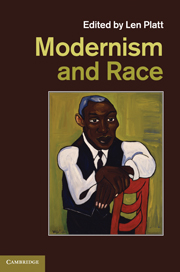Book contents
- Frontmatter
- Contents
- Notes on contributors
- Introduction
- 1 Germanism, the modern and ‘England’ – 1880–1930: a literary overview
- 2 ‘All these fellows are ourselves’: Ford Madox Ford, race and Europe
- 3 ‘’Tis optophone which ontophanes': race, the modern and Irish revivalism
- 4 Generating modernism and New Criticism from antisemitism: Laura Riding and Robert Graves read T. S. Eliot's early poetry
- 5 Race, modernism and the question of late style in Kipling's racial narratives
- 6 Atlantic modernism at the crossing: the migrant labours of Hurston, McKay and the diasporic text
- 7 Claude McKay in Britain: race, sexuality and poetry
- 8 Wyndham Lewis and the modernists: internationalism and race
- 9 ‘Until Hanandhunigan's extermination’: Joyce, China and racialised world histories
- 10 Race, gender and the Holocaust: traumatic modernity, traumatic modernism
- Index
- References
3 - ‘’Tis optophone which ontophanes': race, the modern and Irish revivalism
Published online by Cambridge University Press: 03 May 2011
- Frontmatter
- Contents
- Notes on contributors
- Introduction
- 1 Germanism, the modern and ‘England’ – 1880–1930: a literary overview
- 2 ‘All these fellows are ourselves’: Ford Madox Ford, race and Europe
- 3 ‘’Tis optophone which ontophanes': race, the modern and Irish revivalism
- 4 Generating modernism and New Criticism from antisemitism: Laura Riding and Robert Graves read T. S. Eliot's early poetry
- 5 Race, modernism and the question of late style in Kipling's racial narratives
- 6 Atlantic modernism at the crossing: the migrant labours of Hurston, McKay and the diasporic text
- 7 Claude McKay in Britain: race, sexuality and poetry
- 8 Wyndham Lewis and the modernists: internationalism and race
- 9 ‘Until Hanandhunigan's extermination’: Joyce, China and racialised world histories
- 10 Race, gender and the Holocaust: traumatic modernity, traumatic modernism
- Index
- References
Summary
James Joyce would probably have been appalled at the suggestion of an affinity between himself and E. E. Fournier d'Albe (1868–1933) – a scientist and inventor, who, during his residence in Dublin from 1894 to 1909, flung himself whole-heartedly into the Celtic revival. There is no proof that Joyce personally knew him, but, when Joyce was a student at University College Dublin, Fournier was a ‘celebrity’ and a visible presence in Dublin, who religiously attended the Gaelic League's language classes dressed in Irish costume, and was often seen alongside his friend William Gibson (later Lord Ashbourne), another passionate promoter of Irish national dress, who was ‘invariably in his kilts’. On 18 January 1902, Fournier chaired the general meeting of the Literary and Historical Society of University College Dublin, just two weeks before Joyce gave his famous paper on the Irish poet James Clarence Mangan (1 February). The main topic of discussion was Irish national costume, and the student magazine St. Stephen's, reporting on the meeting and ‘a violent debate’ which took place therein, ridiculed Fournier, who ‘looked pretty in yellow and green’ and who most gladly promoted to the students the Irish costume of his design: ‘We cheered, howled, and asked so many questions about his costume, that Mr. Fournier left, evidently thinking to see three-fourths of the students stalking Grafton Street next day in a robe of that pattern.’
- Type
- Chapter
- Information
- Modernism and Race , pp. 58 - 76Publisher: Cambridge University PressPrint publication year: 2011
References
- 11
- Cited by

